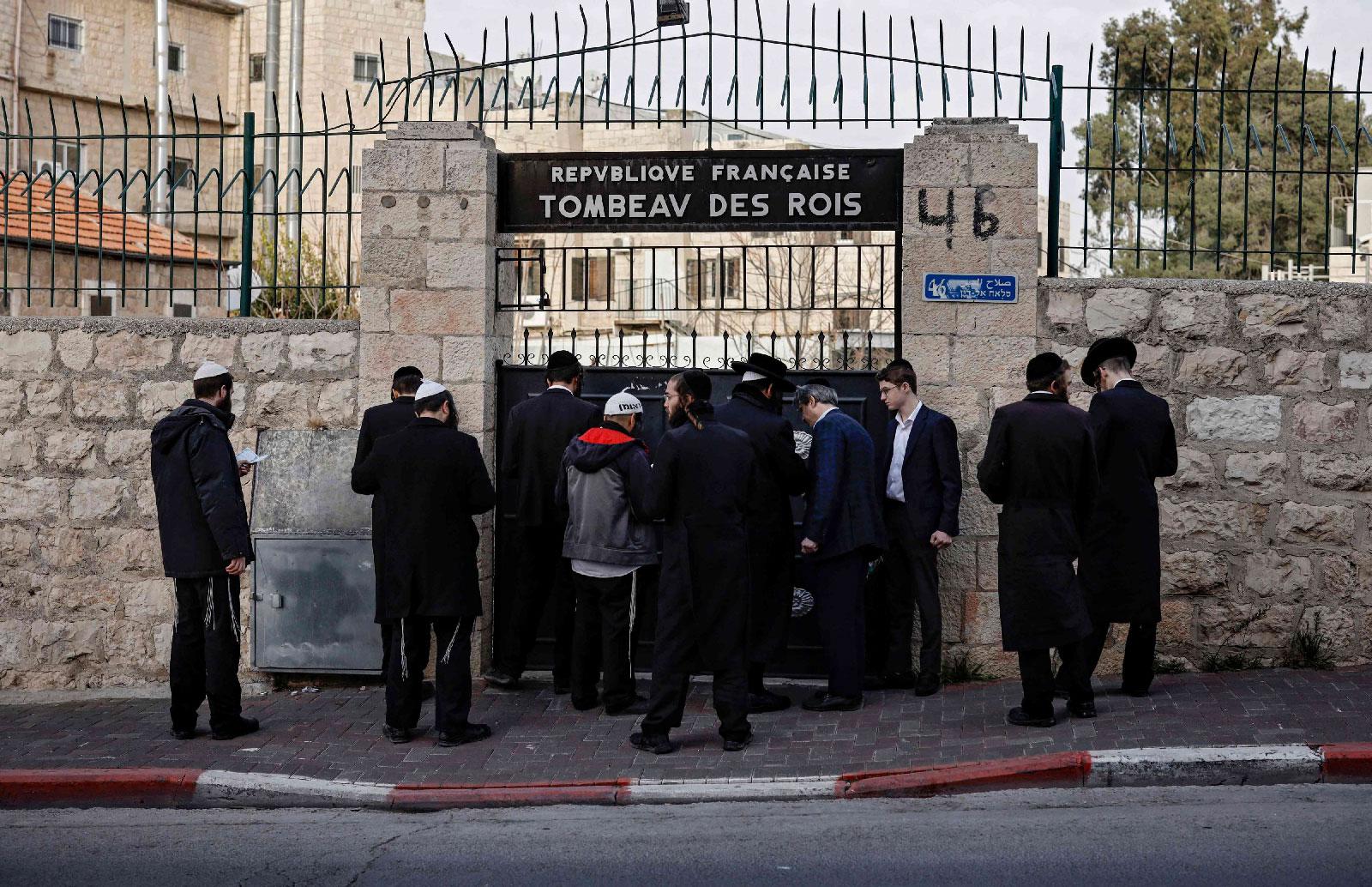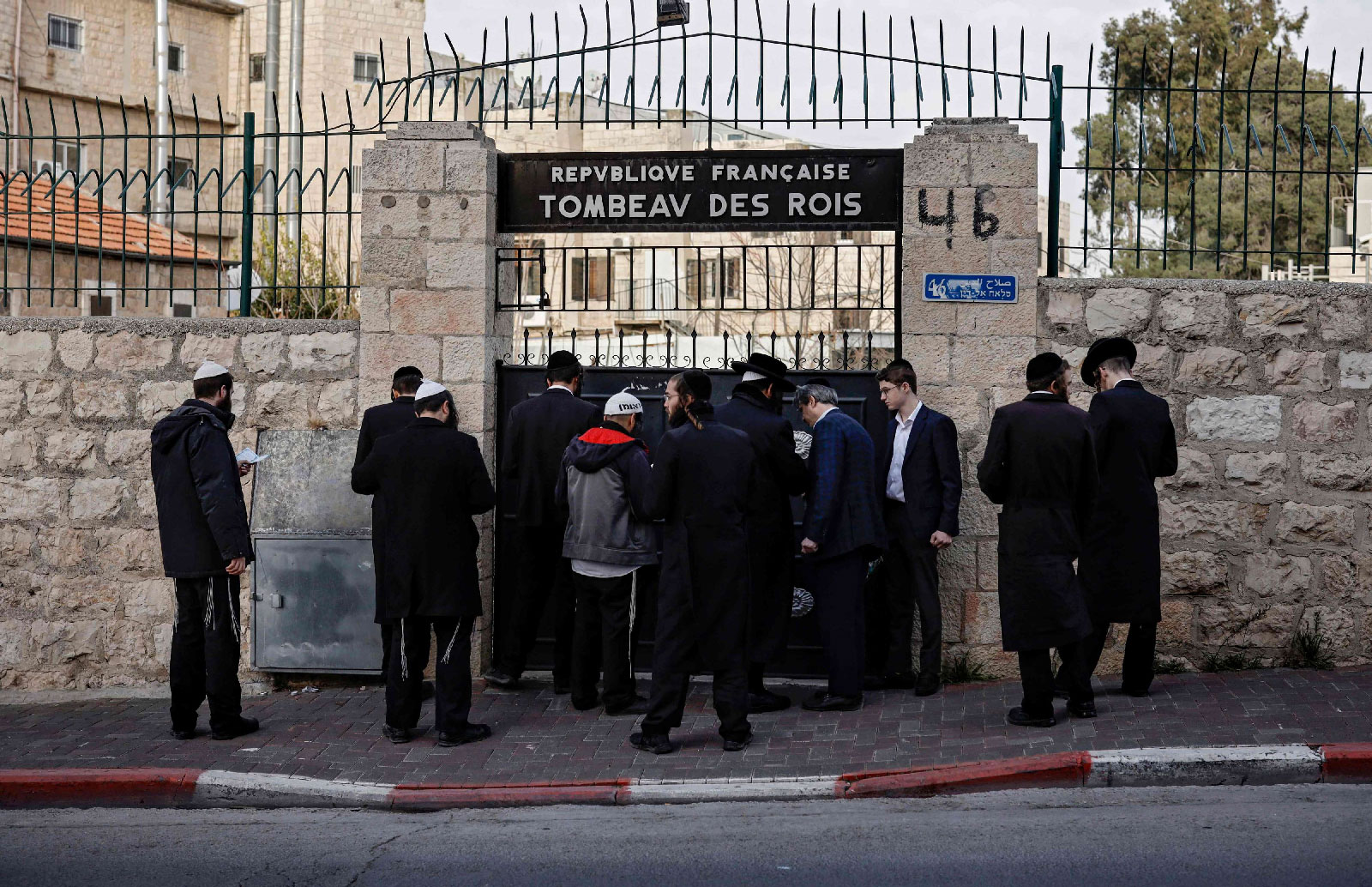A rare look at a Jerusalem tomb reveals fraught politics
JERUSALEM - Flashlight beams pierce the darkness and reveal an archaeological gem in underground Jerusalem few have had the chance to glimpse in recent years.
The elaborate, 2,000-year-old tomb's stone shelves once held sarcophagi, and its steps are hewn from rock connecting its chambers.
It serves as a remarkable example of a Roman-era tomb -- considered among the largest in the region -- but it remains closed for now and largely forgotten in a corner of Arab east Jerusalem, which is occupied by Israel.
Talks are ongoing between France, which owns the site known as the Tomb of the Kings, and Israel to reopen it.
"We are talking about probably the most important, fascinating and large monument in Jerusalem outside the Old City," said Yuval Baruch, Jerusalem regional archaeologist for the Israel Antiquities Authority.
The tomb has been closed since 2010 due to renovations costing around a million euros ($1.1 million).
But its unique status, Jewish veneration of the burial site and its location in the disputed city have added to complications in reopening it.
Archaeological sites in east Jerusalem are often freighted with religious significance and questions linked to the Palestinian-Israeli conflict.
The Tomb of the Kings is no exception, though with international involvement since the site is owned by France.
Israel occupied mainly Palestinian east Jerusalem in the 1967 Six-Day War and later annexed it in a move never recognised by the international community.
It sees the entire city as its capital, while the Palestinians view the eastern sector as the capital of their future state.
France wants guarantees
Groups of ultra-Orthodox Jews have gathered at the tomb's gate to press for its reopening so that they can pray there. They describe it as a holy burial site of the kings mentioned in the Old Testament, David and Solomon.
"All we ask is to enter, make a prayer and leave," said Natanel Snir, who was part of a group of around 12 ultra-Orthodox Jews who briefly gathered outside the gate Thursday.
There has also been a challenge at Israel's rabbinical court - which rules on matters related to Jewish law and holy sites - over access to the tomb and France's ownership.
A concert at the site organised with a Palestinian group that supports the boycott of the Israeli state - until it complies with international human rights obligations - around a decade ago also led to criticism.
This concert is apparently what led the rabbinical court to challenge France's ownership. In 2014, it appointed emissaries in the matter of the 'sacred' property, one of whom - Yitzhak Mamo - is a well-known right-wing activist who has been engaged in evacuating Palestinian families from their homes and replacing them with Jewish settlers, in the Arab neighbourhood of Sheikh Jarrah in occupied East Jerusalem.
The court case has been abandoned for now at the request of Israel's foreign ministry, but there are discussions about whether to resume it, said Rachel Shakargy of the Israeli rabbinical courts.
Before reopening the site, France wants guarantees it will not face legal challenges and is asking for commitments on how visits will be managed. It has also demanded that Israel officially recognize French ownership of the site.
The demonstrations by ultra-religious Jews and their demands to be able to pray on the site have kindled fears among the French that if the site is reopened, it will go the way of many other archaeological sites in Jerusalem by gradually being converted from archaeological-tourism sites into religious sites for Jews and evangelical Christians.
France's concern is that this could constitute an Israeli land grab under the French flag, which could engender serious political complications with Palestine.
French officials declined to comment, while Israel's foreign ministry said negotiations are continuing, without elaborating.
In the meantime, an iron gate leading to ancient steps, ritual baths and the expansive tomb further below remains locked. The group of Ultra-Orthodox Jews praying outside periodically squabble with the guard, who is a Palestinian employed by the French Consulate of Jerusalem.
Queen's tomb?
Both the history of the site and how France came to own it are complex.
An excavation in the 1860s, when the Ottoman Empire ruled the region, is thought to be the first modern archaeological dig in the Holy Land, said Jean-Baptiste Humbert, a French archaeologist who has carried out excavations at the tomb.
Humbert is the current director of le laboratoire d’archéologie de l’École Biblique in Jerusalem, an establishment specialising in archaeology and Biblical exegesis.
Felicien de Saulcy of France took on the project in 1863 and sought to confirm it was the tomb of biblical figures King David and Solomon, giving rise to the site's name.
The earliest excavations conducted by archaeologists from European colonial powers tended to follow the precepts of biblical archaeology, which attempts to establish links between archaeological sites and biblical tradition.
This school of thought has been criticised for presupposing the veracity of Biblical scripture, with archaeologists attempting to fit their discoveries into the preconceived notion that the Bible is a historically accurate text. It has been described as conducting excavations with 'Bible in one hand, spade in the other'.
Israel has often been accused of using the supposed Biblical nature of archaeological sites to establish a 'national' link of all Jews around the world with the land of historic Palestine, as a means to justify its colonial dispossession of indigenous Palestinians.
Today, the theory that the site is the tomb of biblical kings has been ruled out, but the name has endured.
Several sarcophagi were found inside and are now in the Louvre museum in Paris, including one with an Aramaic inscription identifying the corpse within as that of 'Tzadan Malchata'.
According to the most commonly accepted theory, it refers to Queen Helena of Adiabene, in today's Iraqi Kurdistan, and she may have built the tomb for her dynasty.
She is thought to have converted to Judaism and her remains may well have been buried there. Whether or not that is the case, the site is also believed to have been reused over the years.
The tombs are located underneath a piece of land with a small stone house on top of it, which was built and inhabited by an Arab Jerusalemite family.
After de Saulcy's excavation, the burial compound was purchased from its Palestinian owners by the Pereire brothers, a Jewish banking family in Paris that would later hand the property over to France.
'Much too big'
The site is set around 700 metres (yards) from Jerusalem's Old City.
Stone stairs lead down to two ritual baths and a courtyard in front of the tomb itself, with the remains of an ancient frieze above its entry.
The underground tomb spreads over some 250 square metres, slightly smaller than a doubles tennis court.
For Biblical archaeologist Humbert, the site's grandeur and other factors mean it could not have been built for Helena's dynasty.
He theorises it could have been built by Herod Agrippa, grandson of Herod the Great.
"It is a tomb much too big for her," he said.
No matter why it was built, it captured visitors' imaginations before fading from public consciousness.
There are pictures of German Kaiser Wilhelm II visiting in 1898.
For Baruch, the site should be open -- and the artefacts at the Louvre returned.
"In my perspective, it must stay or exist as a archaeological cultural site, and of course if you want as an individual to go there and to pray, you can do it," he said.



